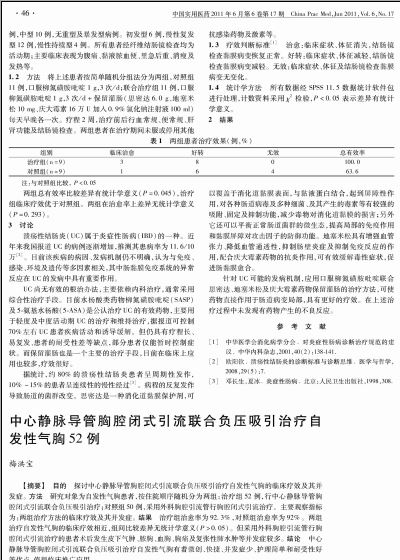中心静脉导管胸腔闭式引流联合负压吸引治疗自发性气胸52例(1)
 |
| 第1页 |
参见附件(3285KB,3页)。
【摘要】 目的 探讨中心静脉导管胸腔闭式引流联合负压吸引治疗自发性气胸的临床疗效及其并发症。 方法 研究对象为自发性气胸患者,按住院顺序随机分为两组:治疗组52例,行中心静脉导管胸腔闭式引流联合负压吸引治疗;对照组50例,采用外科胸腔引流管行胸腔闭式引流治疗。主要观察指标为:两组治疗方法的临床疗效及其并发症。 结果 治疗组治愈率为92.3%,对照组治愈率为92%。两组治疗自发性气胸的临床疗效相近,组间比较差异无统计学意义(P>0.05)。但采用外科胸腔引流管行胸腔闭式引流治疗的患者术后发生皮下气肿、脓胸、血胸、胸痛及复张性肺水肿等并发症较多。 结论 中心静脉导管胸腔闭式引流联合负压吸引治疗自发性气胸有着微创、快捷、并发症少、护理简单和耐受性好等优点,值得临床推广应用。
【关键词】中心静脉导管;胸腔闭式引流;负压吸引;自发性气胸
Closed Drainage of Thoracic Cavity with Central VenousCatheterand Vacuum Suction inTreatment of Spontaneous Pneumothorax:Report of 52 Cases
MEI Hong-Bao.Department of Respiratory Medicine, Ganyu County People’sHospital, Lianyungang 222100, China
【Abstract】 Objective To evaluate the clinical efficacy of closed drainage of thoracic cavity with central venouscatheterand vacuum suction intreatment of spontaneous pneumothoraxand its complications. Methods The studied cases were spontaneous pneumothoraxpatients. They wererandomly divided intotwo groupsaccording tohospital admission time. Treatmentgroup(n=52)were performed withcentral venous catheterdrainage combined withvacuum suction.Control group(n=50)were treated by surgical intrathoracic drain tube.The clinical efficacyand complications of treatments were observed. Results Both methods have achieved the goal of treatment. The treatment group has92.3% of curative rate which was similar to the control group(92%).There is no significant differencebetween the two groups(P> 0.05).However,the control group was associated with more complications such as postoperative subcutaneousemphysema, empyema, hemothorax, chest painandreexpansion pulmonaryedema. Conclusion Closed drainage of thoracic cavity with central venouscatheterand vacuum suction is an easy,minimally invasive, less complications, simply nursing postoperatively, well tolerated and fast way for treating spontaneous pneumothorax. It is worthy of clinicalapplication.
【Key words】Central venous catheters; Closed thoracic drainage; Vacuum suction;Spontaneous pneumothorax
自发性气胸分为原发性和继发性, 前者发生在无基础肺疾病的健康人,后者常发生在有基础肺疾病的患者,如慢性阻塞性肺疾病[1],其治疗根据自发性气胸的病因、积气量的多少及自发性气胸的种类等有所不同,如果气胸量大于20%,或虽然气胸量不到20%,但患者症状明显,或经观察气胸延迟吸收,均应予以胸腔闭式引流治疗。传统的外科胸腔闭式引流存在创伤大及操作较复杂等缺点,需要相关的手术器械 ......
您现在查看是摘要介绍页,详见PDF附件(3285KB,3页)。